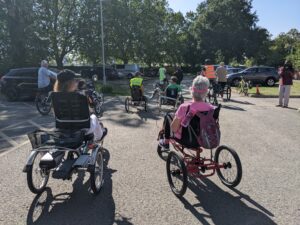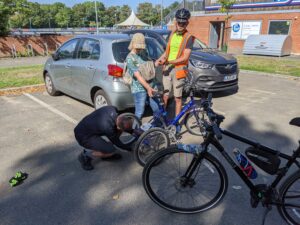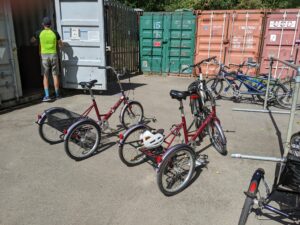Join one of our led rides to exercise, socialise, and explore new places.
Our new article series, by Charles Critchell, discuss every aspect of our London-based cycle sessions and led rides. Since our cycle operations started in 2007, our impactful programmes have helped thousands of Disabled people to try cycling in a safe and supportive environment. This has led to participants experiencing a range of health, wellbeing, and social benefits. This series is designed to bring our collective skills, knowledge, and experience together to create better opportunities for all who want to try inclusive cycling.
Charles Critchell is an active travel professional and a non-Disabled cyclist. For this series, Charles worked closely with Wheels for Wellbeing to learn more about the charity’s cycle sessions and led-rides with the aim of sharing the experiences of its staff, volunteers, and cyclists.
A Ride to Dulwich Park
It’s a cloudless summer’s day in South London as cycling instructor Charlie and session participant Anne pull into the narrow tarmac drive of Herne Hill velodrome on a side-by-side Vanraam trike. Herne Hill is one of three venues which Wheels for Wellbeing run regular cycle sessions, the others being sites in nearby Ladywell and South Norwood. Today, however, the plan is to leave the confines of the velodrome track and venture further afield as part of Wheels for Wellbeing’s ‘led rides’ programme. In addition to offering site-based cycling sessions, WfW often arrange for instructor-led group rides which typically invite participants to explore the local neighbourhood, including some road riding, under the guidance of qualified instructors.

Today’s ride will take the group into nearby Dulwich Park, a short trip from the velodrome and one that offers participants the opportunity to benefit from some exercise, to socialise with fellow cyclists, and to access local amenities that they otherwise may not have been able to. The led ride programme has been running since 2020 and complements the regular cycle sessions. Designed to provide opportunities for participants who want to experience longer rides, the routes are carefully selected by instructors to ensure that all cyclists can join in. Shorter trips are typically scheduled for weekdays between 10.30am – 12.30pm, while longer trips visiting more distant locations are arranged for weekends, one Saturday per month between 10am and 4pm.
A group of cyclists are already assembling as Charlie and Anne pull up alongside a wall of weathered shipping containers. Fellow instructor Beata is helped by volunteer Kirk as they carefully manoeuvre an assortment of trikes, recumbents, and bicycles out of the containers and to the vicinity of waiting cyclists – most of whom are eagerly talking and joking to one another. Just before everyone is ready to leave, Josh, a new cyclist along with his supporter, Johnson, arrive and are quickly astride a pair of Raleigh bicycles having been briefed by Charlie. As we head out of the velodrome Anne soon stops: the chain on her Pashley trike has suddenly dropped. As Beata carries on with the rest of the group, Charlie and Kirk dismount from their own cycles and get to work fixing the issue.

As we wait, Anne tells me her impairment makes it difficult for her to move around and can stop her from performing some tasks. Despite having first cycled with Wheels for Wellbeing over a decade before, changes in her personal circumstances have kept her out of the saddle. With the chain functioning once more, Anne and I proceed, riding abreast, along a quiet residential street having caught up with the rest of the group. She tells me that she’s missed the camaraderie, as well as the more practical benefits of being involved with WfW. These include helping her to develop daily coping mechanisms, along with providing her and fellow Disabled cyclists with a real voice to be able to contribute to the wider conversation about transport and active travel.
As we arrive at the park, I join Josh and Johnson. Johnson tells me that Josh – a Learning Disabled young man – loves cycling, which is the only form of exercise he gets. He also likes to cycle fast which can make it difficult for Johnson to properly supervise him, especially in busy areas. Today the park is quiet, and Charlie rides alongside Josh to offer encouragement and advice, including that Josh learns to use the brakes – instead of his feet – to slow his progress. Led rides are suitable for first-time cyclists, many of whom have supporters to assist them, but are especially good for independent cyclists who are more confident on roads and can use parks, such as Dulwich, to cycle laps for some much-needed exercise.
One such cyclist is Tim, who pulls up on a Kettwiesel recumbent trike having successfully completed a number of laps. Tim was diagnosed with Multiple Sclerosis during COVID, which results in him tiring quickly when carrying out everyday tasks. He explains that he lives close to the velodrome and soon learnt of the WfW cycle sessions taking place there. He enjoys riding the recumbent but finds its weight prohibitive for longer rides. The sessions have enabled him to try other cycles, including an upright e-trike which he’s considered purchasing, however, as with many Londoners, a lack of on-street storage space has so far prevented him from doing so.

The mood among the group is relaxed when we return to the velodrome an hour after setting off. Participants dismount their cycles having had the opportunity to make the most of the pleasant weather, while Charlie, Beata, and Kirk soon begin the process of methodically reloading the cycles back into the waiting containers. Before dispersing, participants discuss upcoming rides including a weekend nature ride with the countryside charity CPRE. As I depart, Anne says she hopes I can join the group for another ride, something she’s intent on doing. I tell her that with so many opportunities to trial different cycles, meet new people, and explore new places I’ll certainly be coming again.
If you’re interested in attending one of our led rides please contact info@wheelsforwellbeing.org.uk to discuss your requirements
